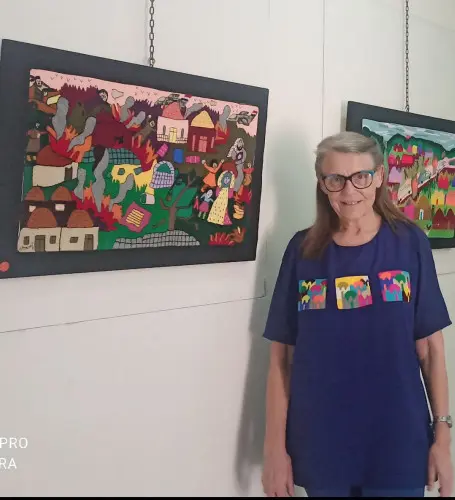German artist Heike Weber who has been residing in Syria since 1982, did not know anything about the “Jabal al-Hoss” area in Aleppo province , before she visited Aleppo, to attend a conference of businesswomen there.
She coincidentally met a number of workers in the United Nations Development Program (UNDP) during the period in which they were completing their projects in a number of areas there.
They asked the artist Weber , who is an expert in embroidery and the owner of a book that documents arts in Syria as well, to continue the work and carry out activities for the residents of “ Jabal Al-Al-Hoss , especially for women.
In 2003, she visited the area in the southeast of Aleppo, once a month, and worked with women of 6 villages there, taking into account the different patterns of embroidery in each village.
The German artist told E-Syria ( Blog) “The stitches used in Jabal al-Hoss in general are called “Bukharistish” in English. It is most likely that its roots go back to the city of “Bukhara” in Uzbekistan.
She added “the ladies used to embroidery large white clothes that they inherited from their grandmothers.
I encouraged them to embroider other things such as bags, paintings and cards for different occasions”.
The artist Weber held the first exhibition of the works of the women of “Jabal Al-Hoss”, at the German Cultural Center in 2005, in which they presented paintings which embodied their lives , including the cultivation of lentils, cumin and barley.
Later, the Syrian women of the “ Jabal Al-Hoss” region developed their talents and increased their incomes to start setting –up their own projects.
“ There are 164 villages in Jabal Al-Hoss region where a quarter of a million people live, and there are only two schools which are 15 km away from the village. It is a long distance for children to go to school, on foot. So I decided to buy a bus to take the children in cooperation with the women of the region” according to the German artist.
Weber’s visits continued until the terrorist war on Syria began in that area in 2012, and when the terrorists groups entered the area , she could no longer travel there so she lost contact with the people.
She told the E-Syria ( blog) “ The area is currently liberated, but the villages are still empty.People cannot return because they have lost everything. I asked the women to embroider what happened to them during the war, and their paintings were about ISIS groups’ attacks”.
After the terrorist war on Syria, Weber held three exhibitions on embroidery of “Jabal al-Hoss”, one in Aleppo and two in Damascus, in addition to small exhibitions and fashion shows in Europe.
She is currently communicating with interested persons and former tourists in Syria, to transfer the new paintings to a number of countries, but she needs someone who supports her interest.
“ We can learn many things from Syrian women and we must support them to keep these handicrafts present. The villagers are part of Syria’s future, and working to build people is a priority.In my opinion, art and handicrafts can contribute to this” according to the German artist.
RawaaGhanam

